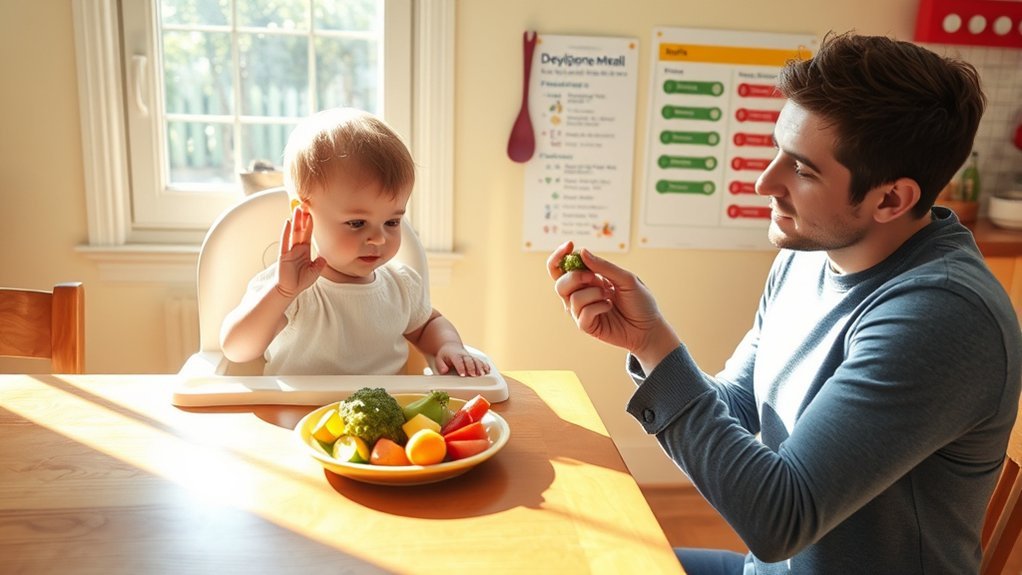Did you know that food aversions in children often arise from their sensory sensitivities rather than just pickiness? As a parent, managing these preferences can feel overwhelming. Understanding the underlying factors can make a significant difference in how you approach mealtime. By exploring the reasons behind your child’s aversions, you can create a more positive eating experience for your family. Discover effective strategies to encourage healthier eating habits that benefit everyone at the table.
Understanding Food Aversions in Children

Understanding food aversions in children can be challenging, especially when you’re trying to guarantee they get a balanced diet. These aversions often stem from a child’s heightened sensitivity to taste and texture, which can be influenced by genetics and past experiences.
It’s essential to recognize that these preferences aren’t merely stubbornness; they’re a natural part of development. Research indicates that repeated exposure to new foods, without pressure, can help reduce aversions over time.
Instead of forcing foods, try offering them in different forms or alongside familiar favorites. Remember, patience is key.
Providing a variety of options while maintaining a positive mealtime atmosphere will encourage your child to explore and gradually accept a wider range of foods.
The Role of Developmental Milestones

As children grow, their food preferences often shift in tandem with various developmental milestones. You might notice changes in what they like or dislike as they reach new stages of growth. This can be linked to their increasing independence, curiosity, and ability to express their preferences.
Here’s a simple table to illustrate some key milestones and their potential impact on food aversions:
| Developmental Milestone | Impact on Food Preferences |
|---|---|
| Starting solids | Initial exploration of tastes |
| Self-feeding | Increased autonomy in choices |
| Language development | Ability to express likes/dislikes |
| Social interactions | Influence from peers and family |
Recognizing these shifts helps you navigate your child’s evolving relationship with food compassionately.
Sensory Processing and Food Preferences

When children explore new foods, their sensory processing can greatly influence their preferences and aversions. Kids often respond to the taste, texture, smell, and appearance of what’s on their plate.
For some, a slimy texture or strong smell can trigger a negative reaction, while others might find these sensations enjoyable. It’s essential to understand that these responses aren’t simply picky eating; they reflect how their brains interpret sensory information.
Encouraging a variety of foods in a positive atmosphere can help expand their preferences over time. You can also assist them by gradually introducing new foods alongside familiar favorites, creating a sense of safety and reducing anxiety around mealtime.
This approach nurtures their exploration and helps develop healthier eating habits.
Emotional Responses to Tastes and Textures
Children’s sensory experiences with food often intertwine with their emotional responses to tastes and textures. When kids encounter a new food, their immediate reactions can reveal deep feelings—delight, disgust, or even anxiety.
Children’s reactions to new foods reflect their emotional connections, revealing joy, aversion, or anxiety tied to tastes and textures.
For example, a creamy texture might evoke comfort for some, while triggering aversion in others. These responses are linked to personal experiences and developmental stages, influencing their willingness to try new foods.
As a parent, it’s essential to recognize that these emotional reactions aren’t just preferences; they reflect complex interactions between sensory input and feelings. Encouraging exploration in a supportive environment can help your child navigate their food experiences, fostering a positive relationship with eating and gradually expanding their palate.
Compassionate understanding is key to this journey.
Common Food Aversions and Their Causes
As you navigate your child’s eating habits, understanding common food aversions can be essential.
Developmental stages, sensory sensitivities, and psychological factors all play a role in what your child may refuse to eat.
Developmental Stages Impact
While many parents encounter food aversions during their child’s developmental stages, understanding the common causes can help navigate this challenging phase. Kids often develop preferences and aversions influenced by their growth, experiences, and environment. For instance, toddlers may reject certain textures as they learn to self-feed, while older children begin to assert independence through food choices.
| Developmental Stage | Common Food Aversions | Potential Causes |
|---|---|---|
| Toddler | Vegetables | Texture sensitivities |
| Preschool | Meat | Flavor exploration |
| School-age | Dairy | Peer influence |
Recognizing these stages allows you to support your child’s journey, encouraging healthy eating habits without unnecessary pressure.
Sensory Sensitivities Explained
Understanding sensory sensitivities can shed light on why your child may reject certain foods. Many children experience heightened reactions to tastes, textures, and smells, making specific foods overwhelming.
For instance, a child might avoid foods with strong flavors or unusual textures, like slimy vegetables or crunchy nuts. These aversions aren’t just picky behavior; they can stem from a neurological response that makes certain sensations uncomfortable or distressing.
Additionally, children with sensory sensitivities might feel more anxious in unfamiliar eating environments, further complicating mealtime. Recognizing these sensitivities can help you approach your child’s food preferences with empathy, allowing you to explore alternative options and gradually introduce new foods in a supportive manner.
Psychological Factors Involved
Food aversions often have deep-rooted psychological factors that can greatly impact a child’s eating habits. These aversions might stem from past traumatic experiences, such as choking or being forced to eat certain foods.
Children may also mimic the food preferences of adults around them, leading to learned aversions. Additionally, anxiety and stress can heighten sensitivity to certain textures or tastes.
Understanding these factors helps you approach your child’s food aversions with empathy. Instead of forcing foods, consider gradual exposure and positive reinforcement.
Creating a safe and supportive mealtime environment can encourage exploration and reduce anxiety around unfamiliar foods. Remember, patience is key, and fostering a healthy relationship with food is essential for your child’s overall well-being.
Impact on Family Meal Times
Family meal times can become a challenge when one or more members experience food aversions, as these preferences often lead to tension and frustration around the dinner table.
You might find that certain foods create anxiety or discomfort for your child, making it difficult to enjoy shared meals. This tension can prompt conflict, as family members may feel pressured to eat foods they dislike or watch others struggle.
Additionally, meal times that should foster connection can become battlegrounds for power struggles over food choices. Understanding and acknowledging these aversions is vital.
It allows you to create a more relaxed dining atmosphere, promoting healthier interactions and emotional well-being for everyone involved while reducing stress during what should be a joyful time together.
Strategies for Encouraging Healthy Eating
When trying to encourage healthy eating in children with food aversions, it’s essential to approach the situation with patience and creativity. Start by involving your child in meal planning and preparation, which can spark their interest in new foods. Offering small portions of various healthy options can reduce intimidation.
Here’s a helpful table to guide you:
| Strategy | Description | Example |
|---|---|---|
| Involvement | Let them choose meals or snacks | Grocery shopping together |
| Variety | Present a range of colors and textures | Colorful fruit platter |
| Fun Presentation | Make food visually appealing | Create fun shapes with food |
| Positive Reinforcement | Praise them for trying new things | Give compliments |
These strategies can help foster a positive relationship with food and promote healthier eating habits.
The Importance of Patience and Flexibility
When it comes to food aversions, embracing different tastes can make a significant difference in your child’s eating habits.
Being patient and flexible with meal planning allows you to adjust to their preferences while still introducing them to new foods.
This approach not only fosters a positive relationship with food but also encourages a more adventurous palate over time.
Embrace Different Tastes
While maneuvering through the complex landscape of children’s food preferences, it’s essential to recognize that each child’s palate is unique and ever-evolving.
Embracing different tastes requires patience and flexibility. Here are some strategies to keep in mind:
- Introduce New Foods Gradually: Present unfamiliar foods alongside favorites to ease the shift.
- Involve Them in Cooking: Let your child help prepare meals; it encourages curiosity about ingredients.
- Model Positive Eating Habits: Show enthusiasm for trying new foods yourself; children often mimic adults.
- Celebrate Small Wins: Acknowledge and praise even the smallest efforts to try new flavors.
Adapt Meal Planning
Adapting meal planning is essential in guiding your child’s food aversions. It’s important to recognize that these aversions can change over time, so being patient and flexible is key.
Start by offering a variety of foods, even those your child may have previously rejected. Gradually reintroduce these items, pairing them with familiar favorites to create a sense of comfort.
Keep mealtimes stress-free and avoid pressuring your child to eat, as this can increase resistance. Consider involving your child in meal preparation, which can spark interest in different foods.
When to Seek Professional Help
Identifying the right moment to seek professional help can be challenging, especially when food aversions disrupt your child’s eating habits and overall well-being.
It’s vital to know when to reach out to a specialist. Consider seeking help if:
- Your child consistently refuses a wide variety of foods, leading to nutritional deficiencies.
- Their aversions cause significant weight loss or slow growth.
- They exhibit extreme anxiety or distress around food, impacting social situations.
- You notice behavioral issues related to mealtime, such as tantrums or withdrawal.
Consulting a healthcare professional can provide you with tailored strategies and support, ensuring your child receives the nutrition they need while addressing emotional factors related to food aversions.
Don’t hesitate to seek help when necessary.
Frequently Asked Questions
How Can I Identify if My Child Has a Food Aversion?
You can identify a food aversion by observing your child’s reactions to specific foods. If they consistently refuse, gag, or express strong dislike, it may indicate an aversion. Keeping notes can help track these patterns effectively.
Are Food Aversions Linked to Allergies or Intolerances?
Surprisingly, food aversions often aren’t directly linked to allergies or intolerances. They can stem from sensory sensitivities or negative experiences. It’s crucial to observe your child’s reactions and consult a healthcare professional for guidance.
Can Food Aversions Change as a Child Grows?
Yes, food aversions can change as a child grows. As they develop, their taste buds and experiences evolve, often leading to increased acceptance of previously disliked foods. Patience and exposure can foster this positive change.
Is It Normal for Children to Have Multiple Food Aversions?
Absolutely, it’s normal for kids to have multiple food aversions. Think of them as tiny food critics, passionately rejecting flavors. As they grow, their tastes often evolve, leading to a more adventurous palate.
How Can I Support My Child Emotionally During Mealtime Struggles?
You can support your child emotionally by staying calm, offering choices, and encouraging small bites. Validate their feelings, use positive reinforcement, and create a relaxed atmosphere, helping them feel safe and understood during mealtime struggles.
Conclusion
Maneuvering food aversions can feel overwhelming, but remember, you’re not alone in this journey. By understanding your child’s sensory sensitivities and developmental needs, you can create a more positive mealtime experience. Imagine a table filled with colorful foods, where every bite is a new adventure—how much easier would mealtime be if you approach it with patience and creativity? Embrace the process, and soon you’ll see your child’s palate expand, fostering healthier habits for the whole family.
